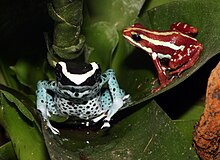| Phantasmal poison frog | |
|---|---|

| |
| Conservation status | |
 Vulnerable (IUCN 3.1) | |
| Scientific classification | |
| Domain: | Eukaryota |
| Kingdom: | Animalia |
| Phylum: | Chordata |
| Class: | Amphibia |
| Order: | Anura |
| Family: | Dendrobatidae |
| Genus: | Epipedobates |
| Species: | E. tricolor |
| Binomial name | |
| Epipedobates tricolor (Boulenger, 1899) | |
| Synonyms | |
|
Prostherapis tricolor Boulenger, 1899 | |
The phantasmal poison frog or phantasmal poison-arrow frog (Epipedobates tricolor) is a species of poison dart frog. It is endemic to Ecuador and known from the Andean slopes of central Ecuador in Bolívar Province. They have radiant colors. This species is endangered, and there are only a few locations in the wild where they are known to live.
Description

The phantasmal poison frog has a snout-to-vent length of about 22.6 mm (0.9 in). It has a wide head and truncated snout and the skin is smooth. The first finger is longer than the second, and all the digits are partially webbed. The dorsal surface is usually green or yellow and there are longitudinal stripes.
Distribution and habitat
The phantasmal poison frog is known only from a number of locations in central Ecuador on the Andean slopes of Bolívar Province, at heights of between 319 and 1,769 m (1,047 and 5,804 ft) above sea level. Its natural habitat is very similar to other species of the poison dart frog family in the leaf litter on the floor of the tropical forest, especially near streams, and in wetlands.
Biology

The species inhabits the Chocoan tropical and subtropical rain forest. Habitats include deforested areas as well as natural forests. They are found in banana and cacao plantations, and pastures near streams. The males carry the tadpoles to sites with running water. The frogs secrete epibatidine, a chemical of pharmacological interest.
Phantasmal poison frogs live in a similar areas to Epipedobates machalilla yet the two to occupy different environmental niches, and their population distribution is small and overlaps with that of E. machalilla. Genetic analysis places phantasmal poison frog clades within E. machalilla and suggests that the phantasmal poison frog diverged recently via either peripheral speciation or high phenotypic divergence.
Status
The phantasmal poison frog is listed as "vulnerable" by the IUCN. This is because of its limited range, estimated to be less than 5,000 square kilometres (1,900 sq mi) and the apparent decline in numbers of this species.
References
- ^ IUCN SSC Amphibian Specialist Group (2019). "Epipedobates tricolor". IUCN Red List of Threatened Species. 2019: e.T55239A98647137. doi:10.2305/IUCN.UK.2019-1.RLTS.T55239A98647137.en. Retrieved 18 November 2021.
- Frost, Darrel R. (2015). "Epipedobates tricolor (Boulenger, 1899)". Amphibian Species of the World: an Online Reference. Version 6.0. American Museum of Natural History. Retrieved 17 April 2015.
- Coloma; et al. (2011). "Epipedobates tricolor". Anfibios de Ecuador. Retrieved 2014-06-28.
- Tarvin, Rebecca D.; Powell, Emily A.; Santos, Juan C.; Ron, Santiago R.; Cannatella, David C. (April 2017). "The birth of aposematism: High phenotypic divergence and low genetic diversity in a young clade of poison frogs". Molecular Phylogenetics and Evolution. 109: 283–295. doi:10.1016/j.ympev.2016.12.035. ISSN 1055-7903. PMID 28089841.
External links
 Data related to Epipedobates tricolor at Wikispecies
Data related to Epipedobates tricolor at Wikispecies